Healthgrades is a sleeping giant.
Half of all Americans who see a doctor this year will visit Healthgrades. They’re the number one platform for patient-doctor connections. This is significant when you realize they have a large number of competitors — many with deep pockets.
How do they retain their #1 spot with consumers?
More importantly, how can you use Healthgrades to boost patient referrals for your practice or clinic? Today we’ll take a look at their platform, showing you how to attract more patients to your practice or clinic and keep it filled in less time.
Here’s what we’ll cover today
Table of Contents
Why is Healthgrades essential to your practice or clinic?
There’s something different about Healthgrades.
Other review platforms tend to focus on profiles, rankings, and reviews. These platforms provide patients with objective data, but it’s all user-generated content — they’re contributing very little on their own.
Healthgrades is different.
Healthgrades evaluates hospitals solely on risk-adjusted mortality and in-hospital complications. They evaluate approximately 500 million claims from federal and private reviews, using that data to rank doctors based on complication rates at the hospitals where they practice, their experience, and patient satisfaction.
Patients trust them.
Here’s why this matters.
It’s a life or death decision. Healthgrades, in their 2018 Report to the Nation, made a startling discovery.
“Patients treated at hospitals receiving a 5-star rating have a lower risk of dying and a lower risk of experiencing one or more complications during a hospital stay than if they were treated at hospitals receiving a 1-star rating in that procedure or condition. From 2014-2016, if all hospitals as a group performed similarly to hospitals receiving 5-stars as a group, on average 219,568 lives could potentially have been saved, and 164,454 complications could potentially have been avoided.”
(Emphasis added)
What does this mean for healthcare professionals listed on Healthgrades?
Reviews matter more than ever.
- 84.3% of adults had contact with the healthcare professional in the past year according to the CDC.
- There are approximately 883.7 million visits to doctors offices each year.
- The average number of visits per 100 persons is 277.9.
- 54.5% of those visits were to primary care physicians.
- 50% of all Americans, an estimated 163.6 million people, visit Healthgrades before seeing a doctor.
- Healthgrades has the largest audience of healthcare consumers anywhere online.
- Healthgrades is the third-largest site for health information.
- 64% of visitors to Healthgrades will make a doctor’s appointment within one week.
- Healthgrades serves more than 20,000 condition areas across their properties.
- Approximately 77% of ratings on Healthgrades are 4 or 5 stars.
What about their competitors?
Insurance claims verify that visitors to Healthgrades go to a doctor more often than visitors to other sites.
- 40% more than WebMD
- 65% more than Everyday Health
Insurance claims also verify that visitors to Healthgrades fill a new prescription more often in the next 30 days than visitors to other sites.
- 40% more new prescriptions filled than WebMD
- 65% more new prescriptions filled than Everyday Health
There is significant criticism within the industry will about their proprietary methodology, but that methodology resonates strongly with patients.
Who visits Healthgrades?
Consumers on Healthgrades are the chief health officers for their families.
Healthgrades taps into a highly desirable demographic, (63% female, HHI $90K, 78% attended/graduated college). These women make the vast majority of healthcare and scheduling decisions for their households.
This is crucial.
It’s important to tailor your message to your audience since the majority of Healthgrades visitors are female.
How Healthgrades compares to other review platforms
Healthgrades helps about 1 million people per day find and connect with a healthcare provider. They have a high-traffic platform that’s in demand; here’s how they compare with other mainstream review platforms.
As a platform, Healthgrades has matured.
Patients trust their platform to provide them with the helpful tools information, research, and tools needed to find the right healthcare provider. Patients have been conditioned by Healthgrades to expect a certain standard of quality on their platform.
It’s a standard other providers have struggled to meet.
It’s true mainstream platforms (Google, Yelp, and Facebook) provide a significant amount of visitor traffic. However, this doesn’t automatically lead to increased traffic and conversion. Healthgrades’ specialization teaches patients to look for precise details that, in a few cases, only they provide.
What your goals should be on Healthgrades
As a mature platform, Healthgrades offers more to providers and facilities than its competitors. Here are some of the goals providers and facilities can accomplish on their platform.
- Superior branding. Most medical professionals don't understand branding. Most marketers don't for that matter. Many believe that their "brand" is a promise, their product or service, a story, or even their logo — it's none of those things. Branding is your reputation. It's the gut feeling patients have about your clinic, hospital, or facility. Healthgrades is an effective way to sculpt and maintain a superior brand.
- Book patient appointments. A clinic or hospital with a completed profile — the right authority, credibility, trust, and performance markers — will receive more scheduled appointments. According to Healthgrades, patients are twice as likely to book an appointment on their platform when your profile is complete.
- Five-star performance reviews. 84% of patients on Healthgrades read your online reviews. This makes sense given the impact reviews have on other industries, but it's even more significant when you remember that reviews are a life or death matter.
- Increased traffic. With consistent effort, you can expect to receive more traffic to your digital and physical addresses. You should receive a steady flow of patients who are interested in specific providers or your clinic in general.
- More physician referrals. A completed profile with the right markers stands out to other physicians as well. Many of these physicians are looking for a highly skilled professional, someone they can make referrals to consistently.
These seem like standard goals.
In reality, they’re not. Goal setting on many other platforms often requires a broad or highly specialized approach. Some platforms focus primarily on booking appointments (i.e., Zocdoc), while other platforms aim to be a large provider of general but useful information (i.e., Web MD).
Claiming or creating your profile on Healthgrades
Healthgrades has information on 3 million providers and counting. If you’re a healthcare professional, there’s a very good chance you’re already listed on their platform. Let’s take a look at how you go about claiming or creating a profile.
1. If you’re a healthcare professional, head over to Update.Healthgrades.com to claim your profile.
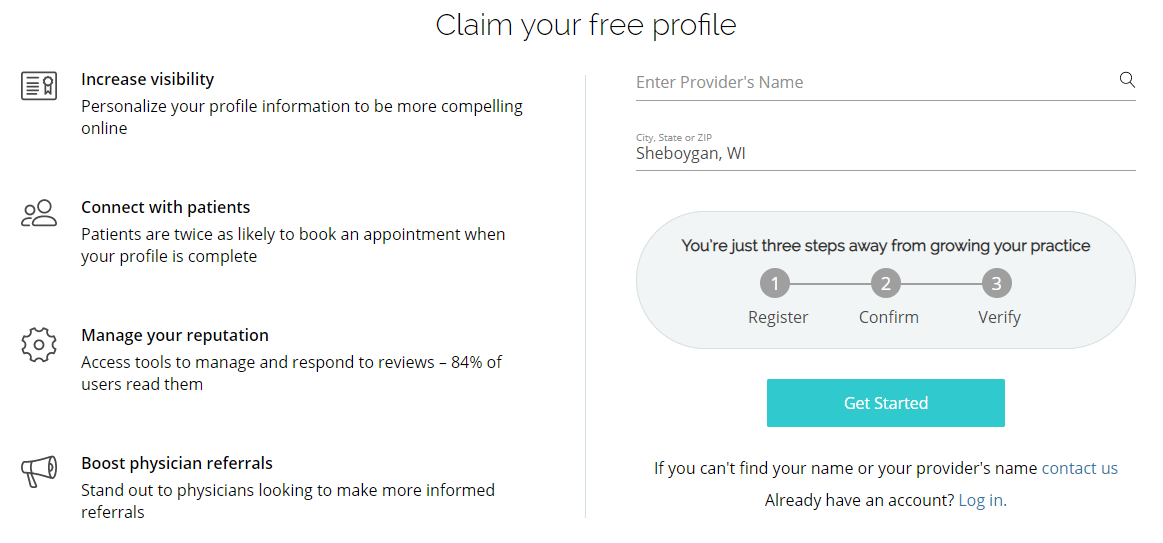
2. Add your name to the “Enter Providers Name ” field, then click “Get Started.” If you can’t find your name, you’ll need to contact Healthgrades directly.
3. Next, you’ll need to confirm your identity, whether you’re the provider in question or a third party representative.
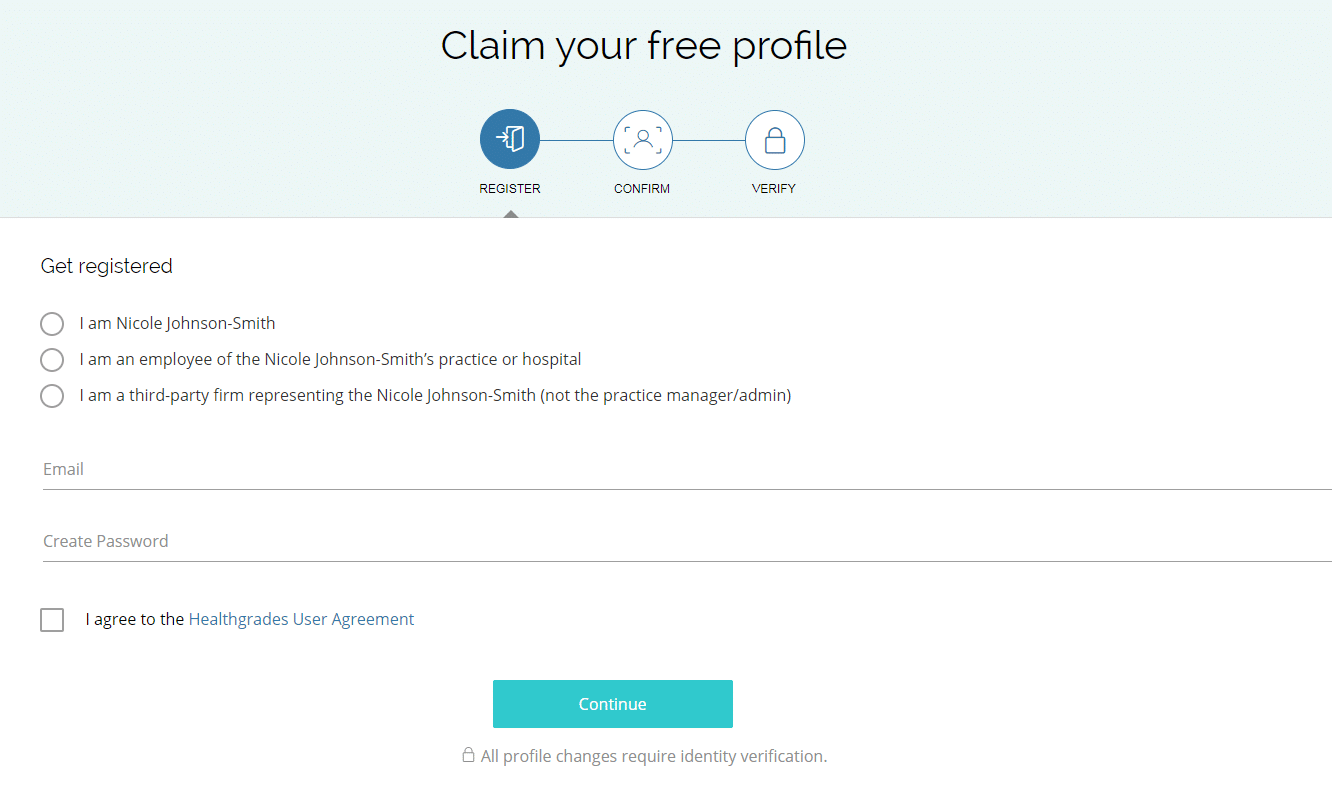
4. Finally, you’ll be contacted by a Healthgrades representative to verify your profile information.

Once you’re verified, you’ll be able to update your profile as necessary with information about your practice, clinic, or facility.
If you’re interested in registering a hospital, clinic, or facility, you’ll want to visit Partners.Healthgrades.com.
Once there, you’ll be prompted to leave your contact information so an expert can get in touch. The tools and resources they provide include customer data platforms (CDP), CRM, patient access, marketing services, quality assurance, and web solutions.
Optimizing your Healthgrades profile
Optimizing your profile is a simple as completing the information listed in your profile. On Healthgrades, the following categories are listed:
Overview. This includes a brief bio, an introductory statement about you, the healthcare professional. In this example, Dr. Nancy Gryniewicz-Sika has opted for something simple and concise. “Dr. Nancy Gryniewicz-Sika, MD, is a family medicine specialist in Oak Park, IL, and has been practicing for 25 years. She specializes in family medicine.”

You’ll want to include a professional headshot, your name, address, phone number, and the name of your clinic or facility.
Locations. This is a map that displays your location along with your physical address, phone, fax, and directions.

This section is short and concise.
Reviews. This section is obvious, it’s a list of the reviews left by previous patients. This section also includes review trends and sentiment analysis, consistent themes that appear in a patient’s review of the healthcare professional. Below are individual patient reviews that can be filtered by recent (the default), highest, lowest, and most helpful.
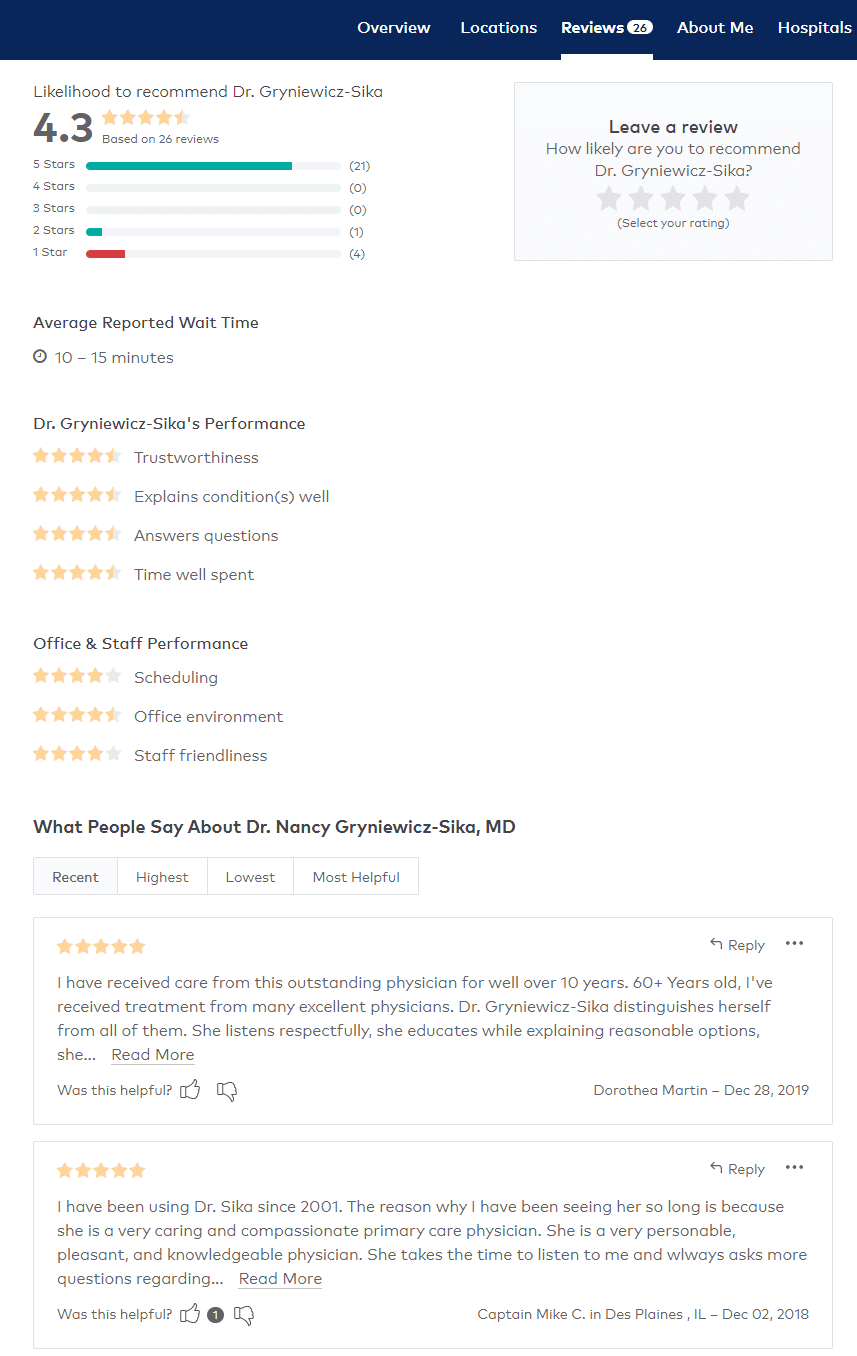
What interesting about this section is the fact that it also lists average reported wait times. It’s a subtle factor to include, but it’s something that can encourage negative or positive reviews depending on each patient’s overall experience.
About me. This section gives you the chance to go into a bit more detail. You’ll want to list your biography, specialties (e.g., family medicine, pediatrics, surgery), board certifications, education, and awards. Provide your patients with the facts they need, don’t use this section to brag or promote your credentials. Your credentials will speak for themselves.
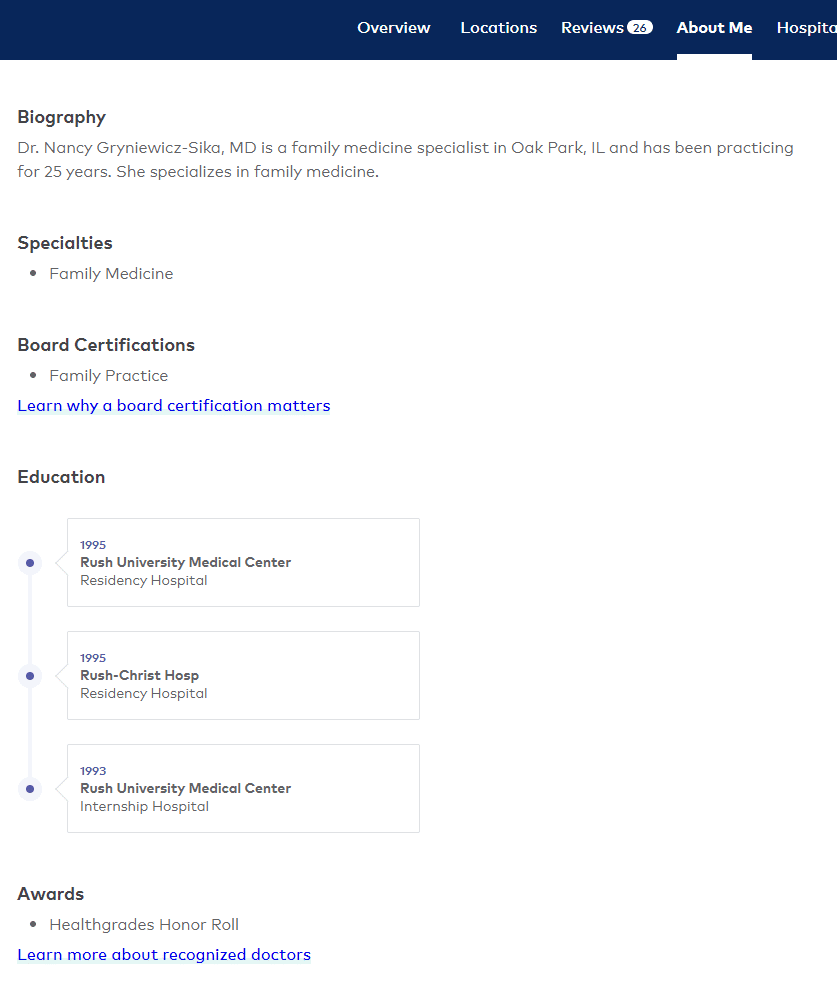
Affiliated hospitals. It’s common for doctors to split their time between several locations. You’ll be prompted to add those locations to your profile. Each location will provide patients with an experience rating (in percentages) and a comparison to the national average and the general area (city, state) of the facility.
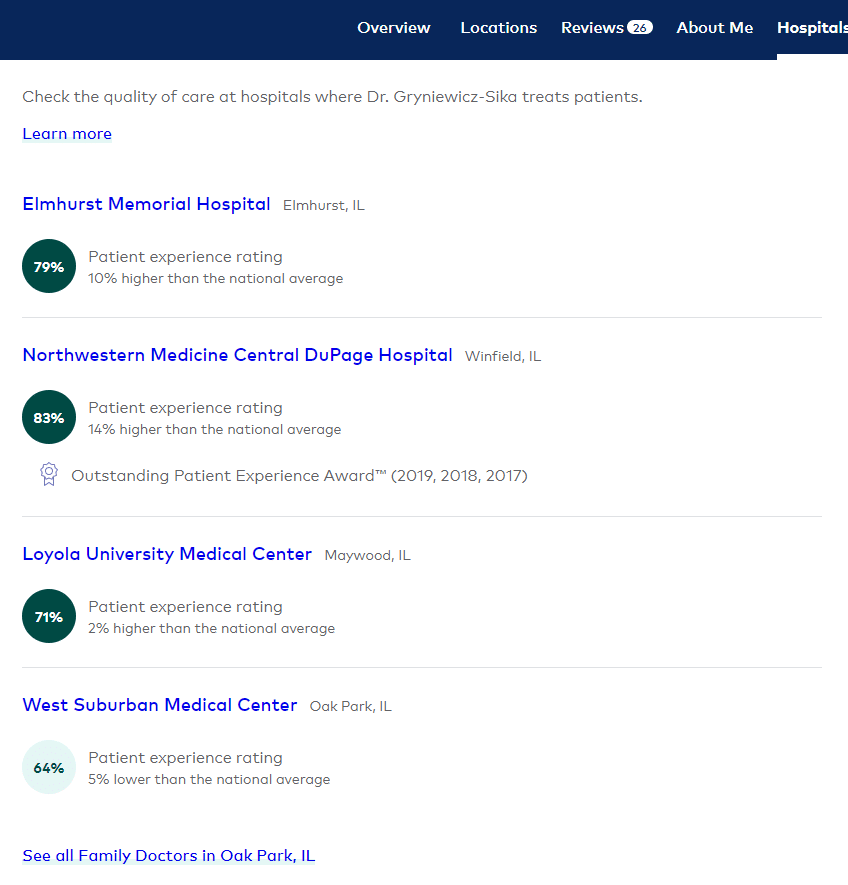
Here’s how you can optimize your profile even further.
Keyword research.
You can include specific variations of the keywords patients use to find a local health professional. For example, if patients are looking for a family doctor, they may enter the following keywords in Google.
- Doctors offices near me
- Female family doctors near me
- Family doctors accepting new patients near me
- Family doctors near me that accept medicare
- Family practice doctors near me
- Family medicine near me
- Primary care physician near me
- Best primary care doctors near me
They may also use the specific city and state in their searches. You’ll want to add these in as tastefully and naturally as possible. Whatever you do, do not stuff your profile with keywords. Choose one or two keyword phrases at the most, then work to include those in your profile bio and descriptions naturally.
If you’re creating a profile for your practice, include a profile for each of your doctors.
Requesting, tracking, and responding to reviews on Healthgrades
Healthgrades shares some surprising discoveries about reviews in their 2020 patient sentiment report. Key findings from the report include:
- Patients most often mention a doctor's skill or care quality when writing reviews.
- In negative reviews, patients mention the factors of wait time, visit time, and office staff up to three times more often than they do in positive reviews.
- Male providers receive higher average star ratings than female providers.
- Reviewers more often mention factors like bedside manner, communication, and visit time in feedback about female providers, while reviews of male providers more often highlight skill and care quality.
- Patient sentiment varies across states: New Jersey and Idaho doctors are among the most highly-rated in the country, while providers in Maine and West Virginia receive lower ratings across many factors.
“Of the 2.4 million text comments on Healthgrades as of December 1, 2019, 95 percent of responses touch on at least one of these six themes:
- Bedside Manner: The patient’s comfort with a doctor and his or her personality; how the doctor makes the patient feel.
- Communication: Whether the patient felt a doctor listened to questions and provided clear information.
- Skill and Care Quality: A patient’s trust in the provider’s ability to provide effective treatment.
- Staff: A patient’s interaction with medical office staff, which patients may also interpret as nurses.
- Visit Time: The total time spent at the doctor’s office, including the appointment. For some patients, a shorter visit time is desirable, while others may value a doctor spending significant time with them.
- Wait Time: The time spent at the doctor’s office waiting for an appointment to begin or between segments of an appointment.
Patients often view a doctor’s skill or care quality through the lens of their own personal result or outcome.”
What does this mean?
Healthcare providers who consistently exceed expectations in one of the six areas will find it easy to attract five-star healthcare reviews. They’ll also find that brand recognition and recall improves as a result of their stellar record.
How do you request reviews from patients?
I made this point in my previous post on Zocdoc.
“There’s a certain amount of professional dignity and distance that goes with your role as a medical provider. It’s something many won’t admit, but it’s vital to preserve that in your role with patients. Can you picture a heart surgeon begging patients for reviews?
It’s a little off-putting, isn’t it?
This is an instance where it’s important to maintain a certain amount of professional distance. If you’re building your review portfolio and you’d like to request a review you can make sure your request comes from:
- Your office
- Someone else in your office (e.g., an office manager)
- A reputable third party”
This advice is true for Healthgrades as well. You’ll want to have a warm and caring someone in your office reach out to patients to request a review on your behalf. Here’s how Healthgrades recommends you do it.
- Educate staff about the importance of online reviews and make them part of your processes.
- Ask patients on their way out of the office.
- Send an email.
- Ask over the phone.
- Add a link to your practice website.
- Provide paper instructions.
- Put QR codes on postcards.
- Thank reviewers.
This is good news!
Other notable platforms state requesting reviews is prohibited on their platform. Healthgrades encourages this and provides you with helpful information you can use to do just that!
Your Healthgrades point-of-contact
When it comes to contact information, Healthgrades prefers to funnel providers and administrators to helpcenter.healthgrades.com. This is disappointing, but it makes sense, given the number of visitors Healthgrades receives daily.
It’s unreasonable to expect that 870 employees can handle customer service for 1 million visitors per day. That said, you can also reach Healthgrades via their social media profiles.
If you’re reaching out on behalf of a clinic or facility, you can also use this contact form to reach out to someone at Healthgrades. If you’re an advertiser, you can call them at 855-539-9625 or 678-279-1900.
Advertising on Healthgrades
With Healthgrades, advertisers can target and filter patients by gender, symptom, condition, geo-location by zip code, and others. In addition to Healthgrades.com, Healthgrades also powers BetterMedicine.com.
“BetterMedicine.com, which provides credible, medically-reviewed content from leading publishers including Harvard Health and the American Hospital Association. Our National Advertising team works with four of the top nine health properties, increasing our reach to over 30 million consumers per month. Through our unique channels pharmaceutical, medical device, consumer goods, and retail pharmacy brands drive engagement and awareness to a massive, relevant audience of patients and consumers.”
Healthgrades’ reach extends beyond their site, giving hospitals and clinics consistent access to prospective patients and their families. Their network includes:
- Physician search and profile pages
- PsychologyToday.com pages
- RightDiagnosis.com
- Condition content pages (i.e., diabetes)
- Third-party partner sites
Here’s the rub.
You’ll need to reach out to Healthgrades directly and speak with an advertising consultant to get started. Healthgrades request more information from you and may recommend their own in-house advertising team if you need help.
As a mature platform, they cater to a wide variety of advertising formats.
Desktop and tablet, display and sponsorship advertising
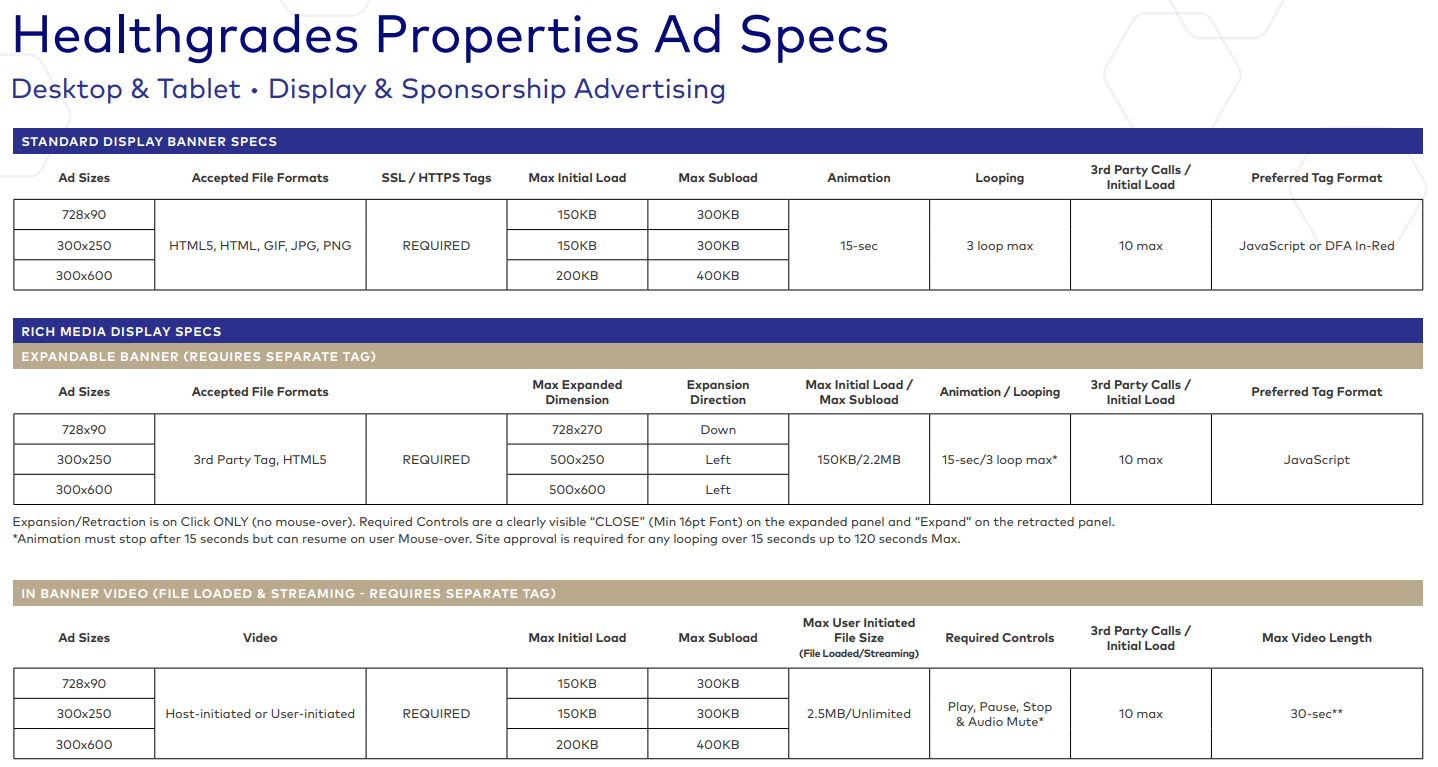
Smartphone, display and sponsorship advertising
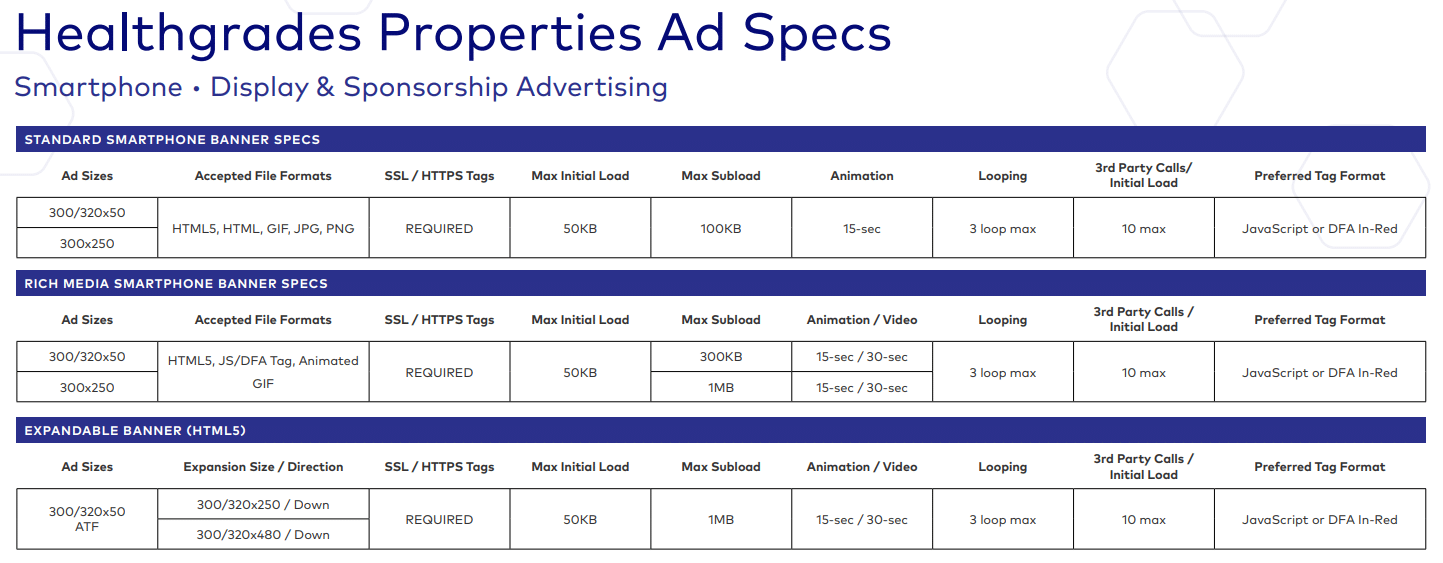
If you’re running your own practice, you have a higher degree of control over your advertising and marketing. If you’re part of a more extensive healthcare system, you don’t have as much control; however, you do have more resources available to promote your business.
Find out what’s available to you.
Then, work to create profiles on other review platforms —Zocdoc, Web MD, Rate MDs, Yelp, etc. Next, reach out to your repeat patients via email. If they wrote a positive review a long time ago (6 months to 1 year ago), they might be willing to do it again. Have someone from your office contact them and ask if they’d be willing to share their review on another review platform.
If they say yes, do the legwork for them.
Provide them with a copy of their review on Healthgrades. Share a link to the review platform of your choice to make things easy for them.
What about new patients?
You can choose to send a set number of patients to an alternate review platform. So, 80 percent of your patients are sent to Healthgrades, while 20 percent are sent to another platform.
A word of advice?
If a patient comes in via Healthgrades, ask them to write a review on Healthgrades. If they arrived via Zocdoc, do the same thing. Don’t make things harder for them than it has to be.
Why go to all this trouble?
Building a strong review portfolio means you’re far more visible in Google. When customers search for a local health care provider, they’ll see wave after wave of five-star reviews on multiple review platforms. They’ll see you everywhere, increasing the number of phone calls, appointments and leads generated for your practice.
Healthgrades Reviews: the secret to boosting patient referrals
Fifty percent of all Americans, roughly 163.6 million people, visit Healthgrades before seeing a doctor. Prospective patients choose carefully because they realize it’s a life or death decision.
Patients treated at hospitals receiving a 5-star rating have a lower risk of dying and a lower risk of experiencing one or more complications during a hospital stay than if they were treated at hospitals receiving a 1-star rating in that procedure or condition.
This is why Healthgrades is #1.
While other platforms focus on profiles, ratings, and reviews, Healthgrades uses this user-generated data to protect prospective patients from mortality and in-hospital complications.
This is how Healthgrades boosts patient referrals.
Fill your Healthgrades profile with the objective data they need, and they’ll show prospective patients why you’re the very best doctor for them.











